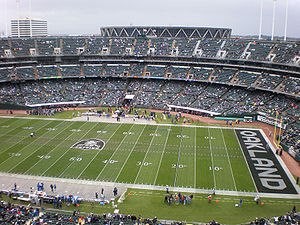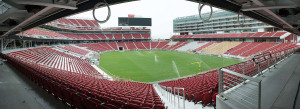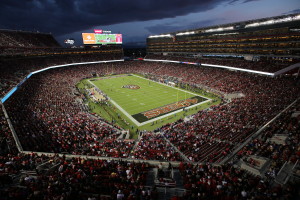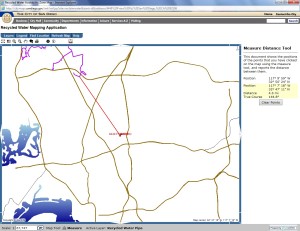On Monday, the San Francisco 49ers played the Minnesota Vikings for the NFL’s first Monday Night Football game of the 2015 season. You may have noticed the awesome bright green grass at Levi’s Stadium, ironic since California is in the midst of an epic 4 year drought. How do they keep that grass so green while we’re being told to let ours die? The secret may be in the water.
Leave it to the San Francisco 49ers to set the bar to a Gold standard when it comes to recycled water use in California NFL stadiums. Not only do they utilize recycled water to meet 85% of their stadiums water needs, but they are the first NFL stadium to be LEED Gold Certified with the United States Green Building Council.
First, let’s establish some known facts. An NFL football field is 57,600 square feet (360′ by 160′). This field size needs approximately 36,000 gallons of water, if one inch of water is to be applied to the entire field. (Extra grass along sidelines means more water used.)
To put this into perspective, if your family of four uses 1400 gallons per week, 26 families would use the same volume of water that a football field will use for 1″ of watering.
Levi’s Stadium – San Francisco 49ers
As previously mentioned, the SF 49ers are already using recycled water at Levi’s Stadium. Provided by South Bay Water Recycling (SBWR) and Santa Clara Valley Water District. This recycled water is treated to strict standards set by the California Department of Health Services so it’s totally ok for its uses in the stadium.
Levi’s Stadium uses recycled water for toilet and urinal flushing, cooling towers, a green roof – which saves on building cooling needs and of course – field irrigation.
The field is planted with a Bermuda Bandera grass from West Coast Turf. WCT provided a little more than 106,000 square feet of grass when it was laid down in 2014.
As written on WCT’s website, new grass (when planted in summer or winter) requires watering four times a day with an inch of water per cycle. After two weeks, the schedule changes to once every day (summer) or every other day (winter) and then after roots are established, every three to ten days with a water depth of 8-10 inches in summer and 4-6 inches in winter. What does this really mean?
Basically – summer watering for a new field at Levi’s Stadium requires nearly 4.4 million gallons of water. WOW! That’s the same volume of water that nearly 800 families of four will use in the same amount of time.
In winter months – when temperatures are below 90°F(!), the field will use just over a half million gallons of water a month.
During last season, Levi’s Stadium was written about quite a few times about replacing the sod. Every stadium, regardless of type, will replace sod several times a year. Whenever an event is held at the venue and the grass will be impacted, it is generally written into the contract that the grass will be replaced. This can cost anywhere between $50,000-$75,000 and use as much as 120,000 square feet of sod.
Oakland Coliseum – O.Co – Oakland Raiders

Credit: West Coast Turf
The Oakland Raiders and the Oakland A’s are the only two teams of Football and Baseball that still share a stadium. That’s pretty cool, the field must be strong enough for the wear and tear the grass will experience.
When it comes to recycled water however, there is a problem. The water district that serves the Oakland Coliseum, the East Bay Municipal Utility District(EBMUD) doesn’t have a recycled water pipeline near the stadium yet.
Abby Figueroa – Senior Public Information Representative of EBMUD said “The Oakland Coliseum with its expanse of turf would be a great candidate to use recycled water for irrigation. The challenge is location. In Oakland, our plant is located at the foot of the Bay Bridge. It’s a great location adjacent to the shoreline that maximizes gravity to move sewage and wastewater into the plant; the tough part is getting recycled water back out.” Bummer. The Raiders’s keep all that grass green with the same water we get out of the tap.
The Oakland Coliseum also receives their grass from West Coast Turf and it is the same kind of grass as at Levi’s Stadium. In the Raiders case, since they share a baseball diamond with the A’s, their field is also part dirt, which will not require as much watering as grass will. Sadly, unlike the Red & Gold in the south bay, they’re on potable water.
Qualcomm Stadium – San Diego Chargers
When it comes to Qualcomm Stadium, shared by the San Diego Chargers and San Diego State Aztec’s, the field is in constant use.
The San Diego County Water Authority serves 1.3 million people and has spent a lot of time, money and energy building a recycled water pipeline in their service area. Except one item to note – Qualcomm Stadium, which uses between 500,000 and 4.4 million gallons of water a month for field irrigation, is 4.5 miles from any recycled water pipelines.
No recycled water available combined with a field that is used nearly every weekend during football season leads to the requirement for a turf that can handle it. Enter what seems to be the industry standard, Bermuda Bandera grass is the go-to choice for California stadiums. West Coast Turf pretty much owns the market for NFL Football Stadiums in the state. The Chargers are no different when it comes to the grass used on their field.
@WestCoastTurf: Bandera Bermuda looking great out @qualcommstadium! #turfgrass pic.twitter.com/ZvDwU50xBO — West Coast Turf (@WestCoastTurf) September 14, 2014
Next weekend, while you’re rooting for your favorite team, spend a moment thinking about how amazing their grass looks. Then compare it to yours outside and question – why doesn’t every stadium use recycled water?






0 Comments
1 Pingback